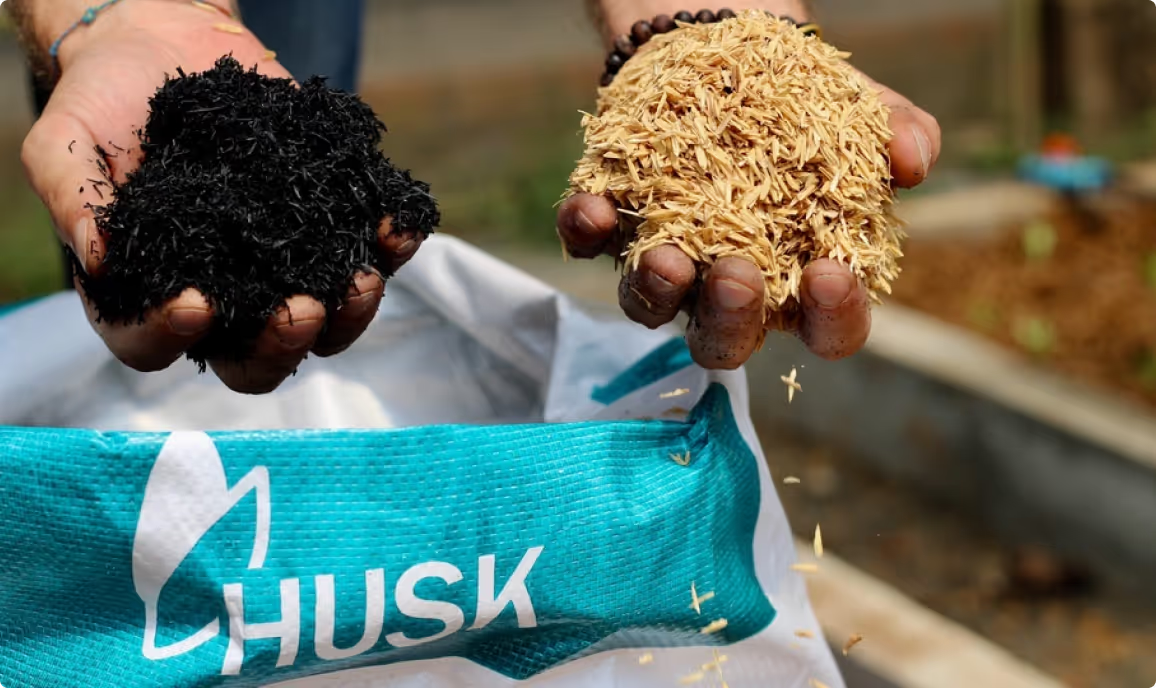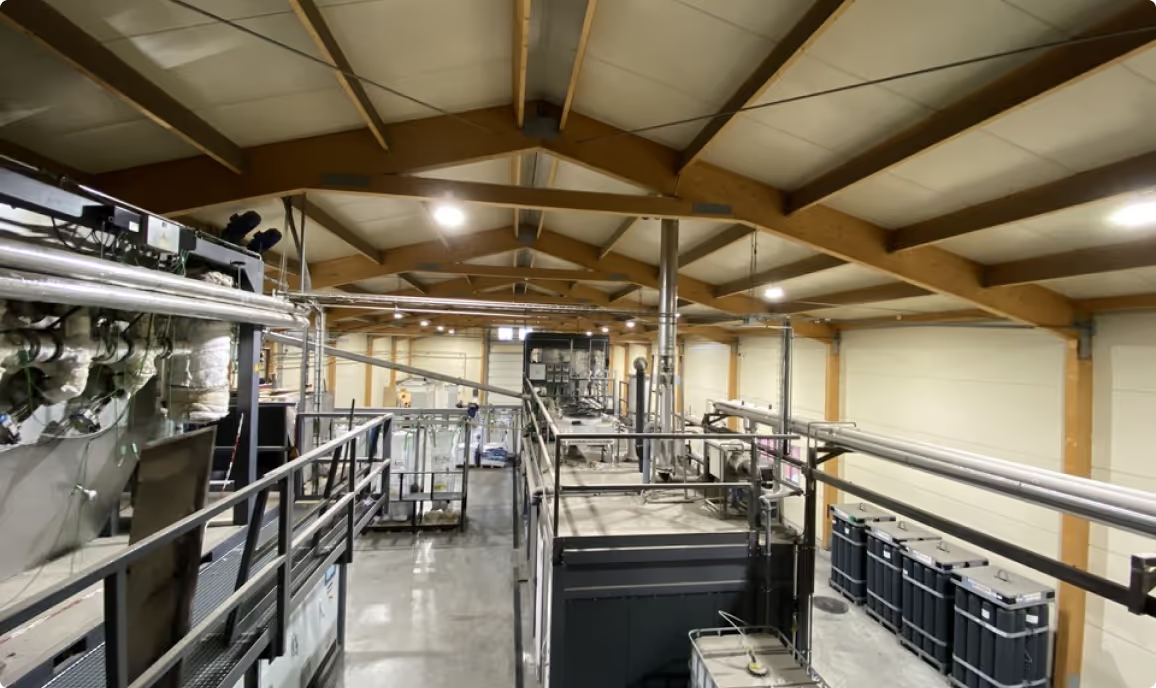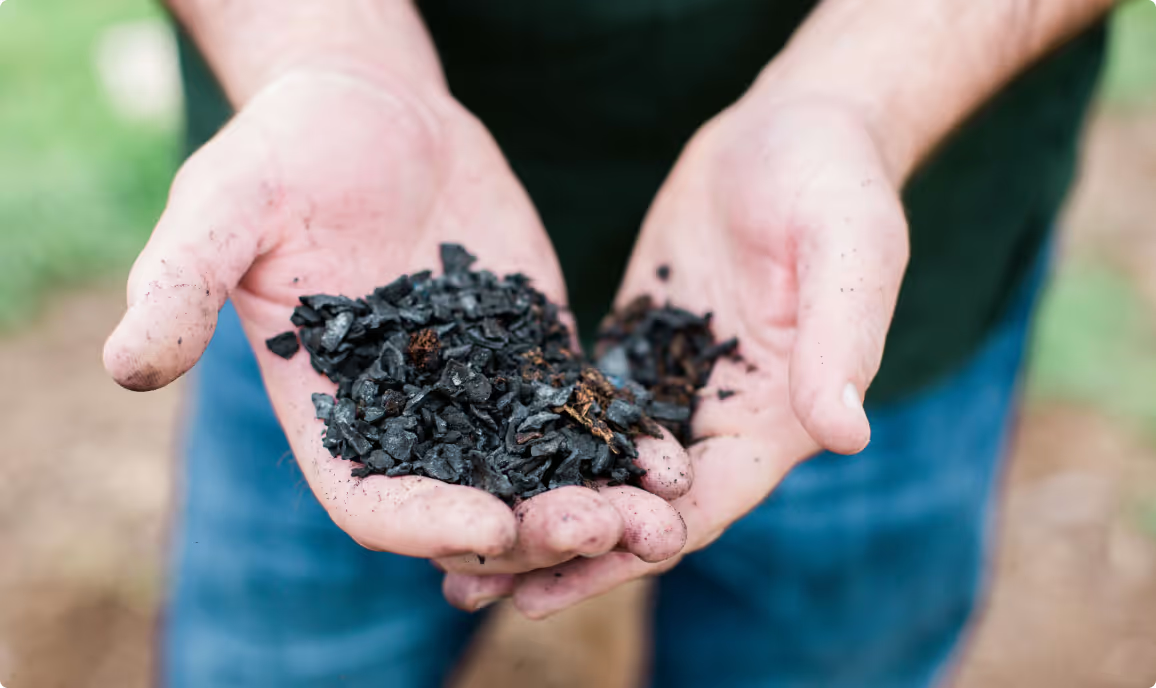Biochar












What you need to know about biochar
- 1Biochar is the output of heating biomass to high temperatures in an oxygen-poor environment, a process known as pyrolysis.
- 2The end result is a charcoal that is chemically stable, rich in carbon, and can be used as a soil additive and for other purposes.
- 3The feedstock biomass can be any plant matter, but to be additional, projects need to use waste biomass (without another use) as their feedstock.
- 4Different types of plant feedstock create biochar with different amounts of carbon and durability.
- 5The pyrolysis process also creates combustible gases including methane and CO₂ as byproducts, which can be captured and used for fuel.
Turning biomass into charcoal
When organic matter is burned or left to decay, it releases its carbon content back into the atmosphere as CO₂. However, biochar projects circumvent this natural process by heating organic matter (biomass) in the absence of oxygen so that no carbon is released, thereby becoming a method of carbon dioxide removal (CDR).
Biochar is the charcoal-like substance that results from this process, and it could hold the key to removing vast amounts of CO₂ from the atmosphere while also offering a host of other benefits: it reduces nitrous oxide emissions in soil, improves soil health, and can be a vector for clean energy production.
When biochar is applied as a soil enrichment, it helps soils form better aggregates, which helps them retain more water and nutrients. In turn, this supports plant growth, decreases dependence on chemical fertilizers, and reduces leaching and runoff. Applying biochar can improve crop yields while reducing emissions of the land used by about 12%. Experts estimate that widespread use of biochar could durably sequester 2.5 gigatonnes of CO₂ each year. To put that in context, we’ll need to achieve approximately 10 gigatonnes of durable CO₂ removal annually by 2050 across all project types in order to meet our climate targets. That means biochar could be a huge part of global climate efforts.
Project showcase webinar: Biochar
We hosted a webinar with Novocarbo and Climate Farmers to understand how biochar can both sequester carbon and revitalize soil health.
Carbon credits and biochar
Biochar is currently the most market-ready form of carbon dioxide removal. To date, biochar projects are responsible for 89% of engineered CDR retirements, and are increasingly being sold as ex-post credits (indicating that many projects are mature enough to sustain themselves and scale without advance financing).
Biochar is frequently compared to afforestation, reforestation, and revegetation (ARR), as this is another CDR option that issues ex-post credits. Unlike biochar, ARR projects have more serious potential for risk of reversal due to natural ecosystem events like wildfires or pest outbreaks, and the natural lifespan of trees is limited. ARR projects also typically have a durability of decades, compared to biochar, which can be stable for hundreds of years.
The history of biochar
Archaeological records point to biochar use in indigenous Amazonian cultures as far back as 2,500 years ago. Known by the Portuguese term “terra preta” (meaning “black earth”), biochar use in agriculture in South America is also referred to by scholars as Amazonian dark earth (ADE). Amazonian communities would ignite a mixture of organic materials, certain tree trunks, and soil, then bury it for combustion, producing biochar, which they’d use as soil fertilizer. ADE is much more fertile than the naturally occurring Amazonian soil, leading scientists to credit the practice in part for forming the basis for a widespread, thriving pre-Columbian civilization with densely populated centers.
However, the earliest biochar practitioners may have been Australian Aborigines, who practiced “fire-stick farming” — igniting moist plant matter to encourage crop growth — as much as 10,000 years ago. Also, evidence of the Aboriginal use of oven mounds containing charcoal, minerals, organic matter, and clay has been discovered in southeast Australia.
Biochar has also been used for centuries in Japan and China to maintain soil fertility.
How is biochar produced?
While there are multiple methods of producing biochar, the principle behind production is consistent: plants absorb carbon dioxide through photosynthesis. Even on working farms or thriving forests, there will inevitably be waste plant biomass (i.e. corn husks, thinned trees, animal manure). This waste biomass becomes the feedstock for biochar production. The feedstock undergoes pyrolysis, and then becomes biochar. Gasses including methane and CO₂ are also released as byproducts during pyrolysis, which can be captured for use or storage. The biochar itself is then reused or stored.
All in all, this process creates three byproducts:
- Biochar
- Natural gas — can be sold or sequestered underground
- Carbon credits
Types of feedstock used to create biochar
Biochar can be versatile as a climate solution, since many types of biomass can be used as feedstock for pyrolysis. Different feedstocks have different underlying chemistry, which has an impact on the stability and carbon composition of the biochar that’s created. Higher stability in the biochar means carbon is less likely to interact with its environment and be released back into the atmosphere. This is known as “risk of reversal,” which is one risk of biochar when used for CDR. Broadly speaking, there are two main categories of biomass used as feedstock in most biochar projects today.
Wood
Wood tends to produce the most stable, highest-carbon content biochar — especially when exposed to very high temperatures during pyrolysis. That means more carbon stored and therefore less risk of reversal. Wood used as biochar feedstock should be biomass from a local forest that would otherwise be left to burn or decay. Some wood decay is important for nutrient cycling. However, wood must be collected in a way that aligns with ecological principles and overall ecosystem health.
Agricultural residue
Farming creates a large amount of waste biomass. This includes crop residue like corn stalks or plant parts that aren’t commercially used. Animal manure is another possible feedstock. Biochar created from this agricultural residue usually has lower carbon content compared to wood feedstock. Each type of agricultural residue will have slightly different properties.
Biochar stability and permanence
Feedstock exposed to different temperatures can also have a different stability. Higher temperatures during pyrolysis tend to create more stable biochar, because more volatile gasses are lost throughout the process.
For biochar, higher stability equals higher “permanence” — the length of time carbon is sequestered. However, it’s not the only factor that determines it. A project should also include the underlying soil health into their measure of permanence. For example, Sylvera uses IPCC projections for soil moisture and heat, as well as burned area, vegetation health, fire danger, and drought severity to understand the risks to permanence beyond the stability of the biochar itself.
Scientists estimate that biochar can be durable for up to or exceeding 1,000 years, depending on factors including feedstock materials, heat of pyrolysis, and environmental factors. Many projects are rated with permanence levels of hundreds of years or more, which exceeds the permanence of forestry projects. Biochar is also the most market-ready form of carbon dioxide removal that also carries a high degree of permanence.
Biomass sourcing
All carbon projects need to account for lifecycle emissions, such as those produced by transport. Biochar projects need lots of feedstock, and it’s best when that feedstock is co-located with (or near to) the pyrolysis facility or kilns to reduce transportation emissions and costs. Local operations that can be installed onsite minimize emissions and are much more efficient.
Additionally, biomass used as feedstock for biochar shouldn’t have land-use competition — meaning projects aren’t just growing biomass to turn into biochar when that land could otherwise be used for sustainable agriculture or forestry.
Biochar leakage and additionality
If a biochar project uses feedstock that could be used productively elsewhere, this will cause “leakage.” “Leakage” refers to the possibility for carbon avoided or removed by a climate project to shift or “leak” to another location, system, or process. In other words, if a project removes some carbon but causes more to be produced elsewhere, that’s leakage — and it must be accounted for.
For example, if manure is being used as fertilizer and is then pulled for use as biochar feedstock, the farm that was originally using the fertilizer will now need to find new fertilizer. Only farming byproducts and waste materials should be used as feedstock — not the ‘fuel’ or the ‘food’ itself. Above all, projects must be highly transparent about the sourcing and origins of their feedstock.
For biochar, leakage is most closely related to a project’s sourcing, since the primary objective is to ensure that a project isn’t sourcing material that has an alternative use. If biomass is diverted from another use toward biochar projects, that other need still exists in the market. That will likely lead to more production of the biomass for those uses with potentially less efficiency. This in turn would create impact outside of the project’s boundaries by impacting external biomass streams — textbook leakage.
The word “additionality” is used in carbon credit projects to talk about the climate impact the money generated by the sale of credits is directly responsible for. Carbon credits are financially additional when a project can demonstrate that it’s only viable because of revenues from carbon credits. This is especially important for projects that generate revenue streams beyond the sale of carbon credits — including biochar.
Because biochar produces goods that are useful and marketable on their own value, carbon credits are only one of three sources of revenue for biochar carbon credit projects:
- The actual biochar can be sold to use on farms to improve soil quality
- Combustible gas like methane can be sold as fuel
- Biochar carbon credits are sold to make the project viable and scalable
Financial diligence for biochar projects therefore focuses on the proportions of funding going to each of these separate streams, and must establish the minimum carbon credit revenue required to make the project viable. The perfect ratio of biochar sales to gas sales to credit sales will likely differ for each project.
The varying scales of biochar projects
Industrial pyrolysis projects
These are industrial-scale projects that rely on are large-scale, automated pyrolyzers or gasifiers that can mass-produce biochar. They’re highly efficient — they can not only sequester CO₂ at scale, but these systems also have effective internal mechanisms to capture gasses emitted as byproducts during pyrolysis. This reduces overall emissions from the process, while also providing the project with gasses that can be sold for reuse.
However, industrial projects don’t necessarily focus on small-scale development as other biochar projects do.
Artisanal kiln systems
Individuals can produce biochar using small kilns, or in some cases open fires. Techniques may even be similar to ancient indigenous practices. This process is much more labor-intensive compared to industrial methods and produces smaller quantities of material.
Furthermore, there are higher process-level emissions associated with artisanal projects, since it’s much harder to capture all gas created during pyrolysis.
On the other hand, these projects create economic opportunities for small communities and can be installed directly at farms, reducing the need to transport both feedstock and biochar. Crop residue can be a source of stress for small-scale farmers in developing countries who don’t have the tools or resources to dispose of these materials. Many smallholder farmers burn their crop residue, which on top of the associated emissions creates local air quality problems, and depletes soils of nutrients. Implementing these artisanal biochar projects can solve a range of problems for smallholder farmers by making this waste material a value add for farming practices. There are often huge co-benefits for developing countries.
Batch systems
Batch systems are between industrial and artisanal methodologies in terms of scale. Typically, these projects are still using kilns instead of pyrolysis facilities, but have scaled enough to develop repeatable processes for small batches of biochar. Batch systems often have a blend of both efficiency and co-benefit advantages.
Capture of methane and other process-related gas
The pyrolysis of biomass to create biochar generates combustible gasses made from the combination of methane, CO₂, and similar compounds. These gasses can represent a huge source of external emissions if not accounted for or captured within the project’s boundaries.
Biochar projects have two options. Either A) capture all greenhouse gasses emitted during production (which can then be sold as natural gas or stored), or B) calculate the proportion of gasses not captured and deduct that number from the final carbon audit, so that the project accounts for these emissions losses.
Most projects do at least some of both of these options. Large-scale pyrolyzers can be very efficient at capturing gasses, however, there’s almost always at least some residual emissions that aren’t captured. No matter how large or small these residual emissions are, full accounting must be made of them and factored into the carbon audit of the project.
While biochar has potentially high permanence — especially PAC — it is sequestered in soil. As such, both human and natural activity can cause the carbon to be prematurely released back into the atmosphere.
Biochar projects need to measure and protect against causing emissions leakage from changes in land management outside the project area, such as sourcing new biomass rather than existing stock.
Accurately estimating what would have happened to biomass feedstock in the absence of the biochar project is key to calculating the additionality of the carbon credits. Also, protecting people’s food sources from use as biomass is a concern.
Biochar has two carbon sink pools: polycyclic aromatic carbon (PAC) and semi-persistent carbon (SPC). SPC is durable for 50-100 years, PAC can persist for 1000 years in many soil types and climates.
Bio-oil and syngas are byproducts of producing biochar, and can be used to generate heat and electricity.
Biochar can be used for water filtration, as a soil amendment, or added to animal feed to reduce emissions from livestock agriculture and improve animal health.
Want to accelerate climate solutions like biochar? We want to hear from you.









